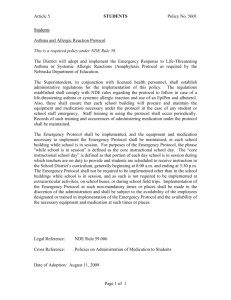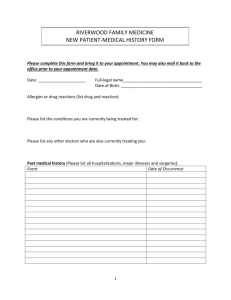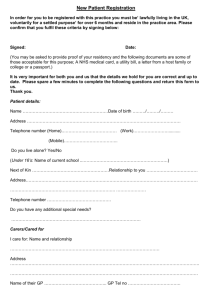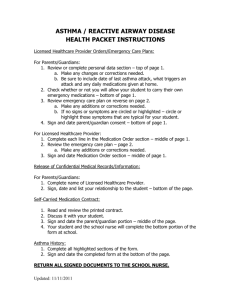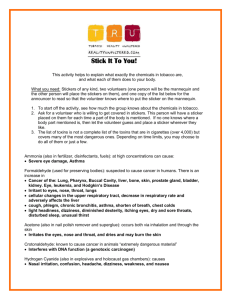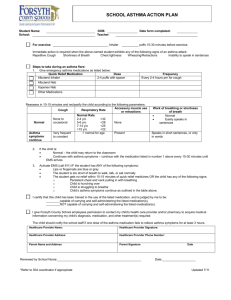Medication List - Miranda Fuerstenberg
advertisement
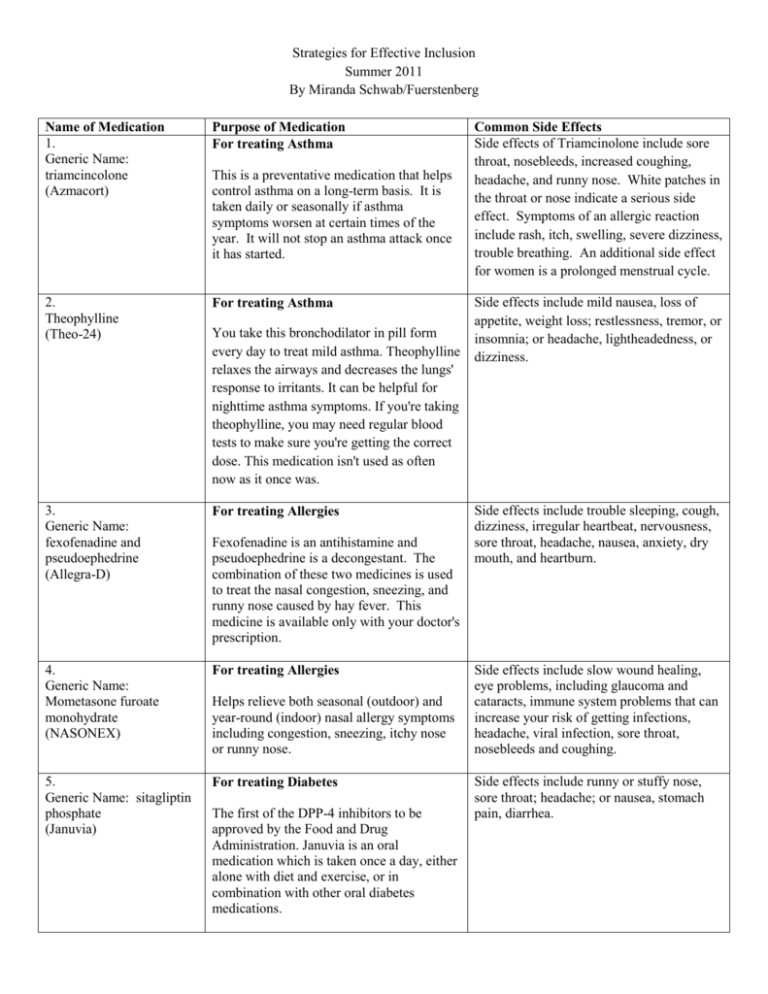
Strategies for Effective Inclusion Summer 2011 By Miranda Schwab/Fuerstenberg Name of Medication 1. Generic Name: triamcincolone (Azmacort) Purpose of Medication For treating Asthma 2. Theophylline (Theo-24) For treating Asthma 3. Generic Name: fexofenadine and pseudoephedrine (Allegra-D) For treating Allergies 4. Generic Name: Mometasone furoate monohydrate (NASONEX) For treating Allergies 5. Generic Name: sitagliptin phosphate (Januvia) For treating Diabetes This is a preventative medication that helps control asthma on a long-term basis. It is taken daily or seasonally if asthma symptoms worsen at certain times of the year. It will not stop an asthma attack once it has started. You take this bronchodilator in pill form every day to treat mild asthma. Theophylline relaxes the airways and decreases the lungs' response to irritants. It can be helpful for nighttime asthma symptoms. If you're taking theophylline, you may need regular blood tests to make sure you're getting the correct dose. This medication isn't used as often now as it once was. Fexofenadine is an antihistamine and pseudoephedrine is a decongestant. The combination of these two medicines is used to treat the nasal congestion, sneezing, and runny nose caused by hay fever. This medicine is available only with your doctor's prescription. Helps relieve both seasonal (outdoor) and year-round (indoor) nasal allergy symptoms including congestion, sneezing, itchy nose or runny nose. The first of the DPP-4 inhibitors to be approved by the Food and Drug Administration. Januvia is an oral medication which is taken once a day, either alone with diet and exercise, or in combination with other oral diabetes medications. Common Side Effects Side effects of Triamcinolone include sore throat, nosebleeds, increased coughing, headache, and runny nose. White patches in the throat or nose indicate a serious side effect. Symptoms of an allergic reaction include rash, itch, swelling, severe dizziness, trouble breathing. An additional side effect for women is a prolonged menstrual cycle. Side effects include mild nausea, loss of appetite, weight loss; restlessness, tremor, or insomnia; or headache, lightheadedness, or dizziness. Side effects include trouble sleeping, cough, dizziness, irregular heartbeat, nervousness, sore throat, headache, nausea, anxiety, dry mouth, and heartburn. Side effects include slow wound healing, eye problems, including glaucoma and cataracts, immune system problems that can increase your risk of getting infections, headache, viral infection, sore throat, nosebleeds and coughing. Side effects include runny or stuffy nose, sore throat; headache; or nausea, stomach pain, diarrhea. Name of Medication 6. Insulin-pump or injections Purpose of Medication For treating Diabetes Insulin allows the body to process glucose. Without it, high blood pressure can develop. 7. Generic Name: methylphenidate extendedrelease (Metadate CD) 8. Generic Name: Amphetamine (Adderall) 9. Generic Name: diazepam (Diastat) 10. Generic Name: olanzapine (Zyprexa) For treating ADHD The capsules are specially designed to release 30 percent of the medication immediately and the other 70 percent slowly, which allows the drug to be taken just once a day. Because Metadate CD is a stimulant and is commonly abused, there are special rules for prescribing it. While stimulants (like caffeine) can cause hyperactivity, this medication has a calming effect. For treating ADHD Adderall is a central nervous system stimulant. It affects chemicals in the brain and nerves that contribute to hyperactivity and impulse control. For treating seizures It is available in a gel form that is inserted into the patient’s rectum to stop a cluster of repeated seizures. For treating bipolar I Approved for the treatment of schizophrenia, acute manic or mixed episodes of bipolar disorder, and for maintenance treatment of bipolar disorder. Common Side Effects Insulin does not have side effects, but teachers should be aware of the symptoms of low and high blood sugar so they can keep an eye on insulin-dependent students. Low blood sugar symptoms: trembling, clammy skin, anxiety or irritability, sweating, dizziness or lightheadedness, and heart palpitations High blood sugar symptoms: fatigue, thirst, increased urination, vision changes, moodiness or decreased ability to concentrate, and numbness or tingling of the hands and feet Side effects include headache, loss of appetite, abdominal pain (stomach pain), and insomnia. Side effects include headache or dizziness; sleep problems (insomnia); dry mouth or an unpleasant taste in your mouth; diarrhea, constipation; loss of appetite, weight loss; or loss of interest in sex, impotence, or difficulty having an orgasm. Side effects include decreased coordination, diarrhea, dizziness, drowsiness, headache, nervousness, stomach pain, and stuffy nose. Side effects include sleepiness, increased appetite, dizziness, lack of energy, changes in behavior, tremors (shakes), dry mouth, restlessness, and having hard or infrequent stools.
